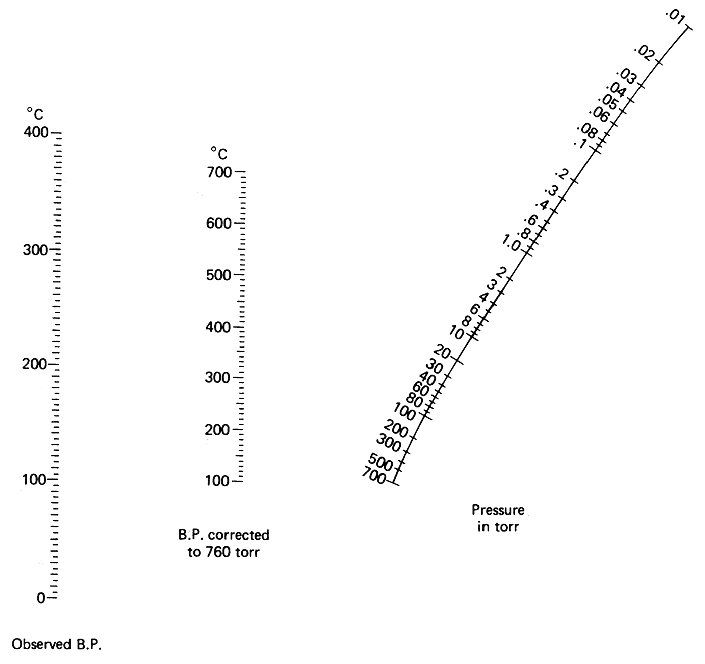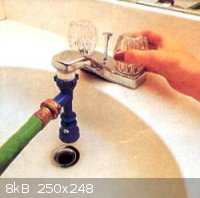firecreature
Harmless

Posts: 3
Registered: 20-9-2011
Location: British Columbia
Member Is Offline
Mood: unstable
|
|
Create a Stronger Vacuum with Dual Aspirators?
If you combined two water aspirators with a Y-joint to the vacuum adapter of a distillation apparatus, would the vacuums of the two aspirators work
together to create a stronger vacuum or would the two vacuums conflict with each other?
I would test this my self if I had access to two Aspirators. Unfortunately I only have the one and can't really afford to buy a second aspirator for
experimental purposes. I imagine the physics people would understand this better then I do. Thanks for all your guys help in advance.
-fire creature.
|
|
|
Mr. Wizard
International Hazard
    
Posts: 1042
Registered: 30-3-2003
Member Is Offline
Mood: No Mood
|
|
You might draw more volume, but the lowest pressure you could draw would still be the vapor pressure of water, as determined by it's temperature,
dissolved gas content, and pressure. Since the aspirators would be in parallel they would increase the total amount of gas that 'could' be drawn
through them. You would have to have a bigger cross section of opening feeding from the Y to the volumes under suction. If you were approaching the
limits of what one aspirator could draw in volume, you could get a lower pressure when drawing larger volumes.
In other words no lower maximum vacuum, but more volume of gas drawn through. BTW, the cheap pumps they sell for cleaning fish tanks, and drawing
water out of water mattresses are very cheap, and made of plastic. If plastic won't be a problem you can experiment with one .
|
|
|
firecreature
Harmless

Posts: 3
Registered: 20-9-2011
Location: British Columbia
Member Is Offline
Mood: unstable
|
|
Thanks Mr. Wizard. That clears things up for me.
Are the waterbed and fish tank pumps Water Aspirators as well? If so I will certainly look into it. If the price is right I may try running a parallel
set up just to satisfy my own curiosity.
Thanks Again!
|
|
|
peach
Bon Vivant
    
Posts: 1428
Registered: 14-11-2008
Member Is Offline
Mood: No Mood
|
|
Mr Wizard is correct, the minimum pressure they can achieve is fixed by the vapour pressure of the fluid going through the jet.
If you take a nomograph;

Place a ruler on the screen or print it and do the same. Lie it horizontal so it spans all three lines. Using the middle line, the atmospheric boiling
point, slide the ruler down to 100C (water). If the ruler is horizontal, it'll be reading 100C on the left line as well, and 700 on the right (which
is basically atmospheric pressure). Now pivot it anticlockwise about that middle line (on the 100C mark) so the left line reads something near room
temperature.
The other side, on the right, will start going up the line to a lower pressure, showing the pressure the water will boil at when at that new
temperature. 30 - 40mBar is normal for an aspirator.
This points out an important aspect of aspirators, that the pressure is related to the temperature of the water going through. So, if you cool the
water towards 0C, the pressure will drop a little more. If, on the other hand, your pump warms it up to 60C (for instance), the pressure rises.
A piston style fridge compressor will manage about the same vacuum as an aspirator, and a little bit lower (10mBar) if the oil is replaced. The rotary
ones from air conditioner units in the US are better in terms of pressure, managing more like ?1mBar?. However, they also get scorching hot.
You can chain two compressors together to help create a slightly better vacuum, but the difference is only tens of mBar or less. The same would be
partially true of aspirators if the aspirator is not perfect. The difference is not really worth it.
100mBar is fine for filtrations. 100 to 10mBar, filtration, boiling solvents off and accelerating drying. You can also distil some higher boiling oils
around 10mBar. 1mBar and below is for things that need to be well isolated from the atmosphere, e.g. distilling things that'll decompose before they
ever make it to the condenser.
I would be interested to know how low the aquarium style pumps will go, as I know some diaphragm pumps can manage all the way down to 0.1mBar. I doubt
an aquarium pump will, but it's interesting none the less.
[Edited on 30-9-2011 by peach]
|
|
|
Mr. Wizard
International Hazard
    
Posts: 1042
Registered: 30-3-2003
Member Is Offline
Mood: No Mood
|
|
firecreature, yes the aquarium and waterbed pumps are made primarily to handle water, and will screw directly onto most (standard USA ) faucet bibs.
They are usually made of a styrene like plastic, so various solvents, especially ketones will destroy them. They are actually just one step above
being complete junk. My wife has been using one for years to clean and change water in a 100 gallon aquarium, and I'm surprised it hasn't broken yet.
The fitting on the units are made to fit hose bib, and garden hoses, so you would have to make adapters, but a visit to the plumbing section of any
large hardware store would get you the fittings, that would most likely cost more than the pump.
The controls on the pumps also allow you to send water down the suction line, so be careful when using one that you don't drown what you plan to draw.
Water bed supplies are not as common as they used to be. I've included a link for a fish supply that carries a similar product. You would only need
the part called a 'flow valve'.
http://www.fosterandsmithaquatics.com/1/1/2069-aqueon-aquari...

|
|
|
|